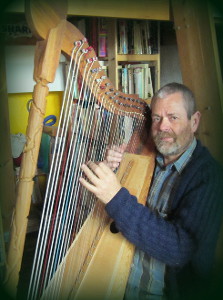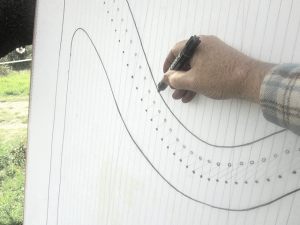
Didier Saimpaul: During the past few years, the number of harp makers, whether amateurs or professionals, has grown significantly. Consequently, the interest in learning artistic and technical drawing has grown. During the festival, Sylvestre Charbin gave a workshop on making harps where students used existing plans. In my workshop, students learn how to draw such plans. In just three hours, one can understand the essentials of the work and take home the plans ready to make a harp.
I based my workshop on Jeremy Brown’s book Folk Harp Design and Construction which I translated into French with the title Concevoir et Construire les Harpes Celtiques. The method is fairly simple: we start by sketching the shape of the harp on a drawing board; draw the harmonic curve – i.e. the length of the strings – according to the notes and the kind of strings; then, draw the "layout" of the instrument. Contrary to what one might think, the beginning starts from the strings to the rest of the instrument and not the reverse.
Once the structure is finished, and as long as some basic rules are followed, everything is possible, so that everyone may freely express his or her own creativity. If the space between the strings is defined beforehand on the board, much remains to do: what angle between the strings and the soundboard (from 25° to 40°)? What percentage of tension should be applied to each string? Where should the bridge and tuning pins be fixed? The neck has to bear the tension of the strings (between 200 and 300kg for a 22 string harp and between 600 and 800kg for a 36 string harp), what form to give to the neck? How much space does it take on this neck in order to place the sharping blades? Keeping in mind that the bass strings will have a bigger sound with a soundbox upwards tapered (the most common), whereas a straight and narrow soundbox gives a shallower and nasal sound, what form to give to this soundbox? Then comes the pillar, linking the neck to the bottom of the harp: its shape can be from straight (pedal harp, Paraguayan harps), to the characteristic curve of the Celtic harps, etc., etc. There are plenty of steps and the purpose of my workshop is to help people at the very beginning of harp making.

Building harps is my passion. Following the translation of the book mentioned above, I created a blog called harpomania where I publish articles about building harps. François Hascoët and his team published Telennourien Vreizh in the 80s, then there was also Le Journal de la Harpe. It shows the public interest in reading such publications. But printed editions are very expensive; this is the reason why Telenn din – La Maison de la harpe’s newsletter – is published online. For me, the opportunity came when one day I found software to create magazines. After talking to Stephan Lemoigne – harp player and amateur-harp maker since the 70s – we launched the project. Earlier last year we released the first issue of Harpes Mag’, reaching more than 1500 people.
Since then, we published all kinds of articles about the Celtic harp: harp making, history of the instrument (such as the article on the The Golden Lyre of Ur also published on this blog), iconography, as well as musicians, their albums and even sheet music. Literature is one of my main interests; I would like to develop a part dedicated to the harp and poetry in the magazine. Once I was teacher of literature; people can not change their nature! The magazine is open to all who wish to participate, everybody is welcome!